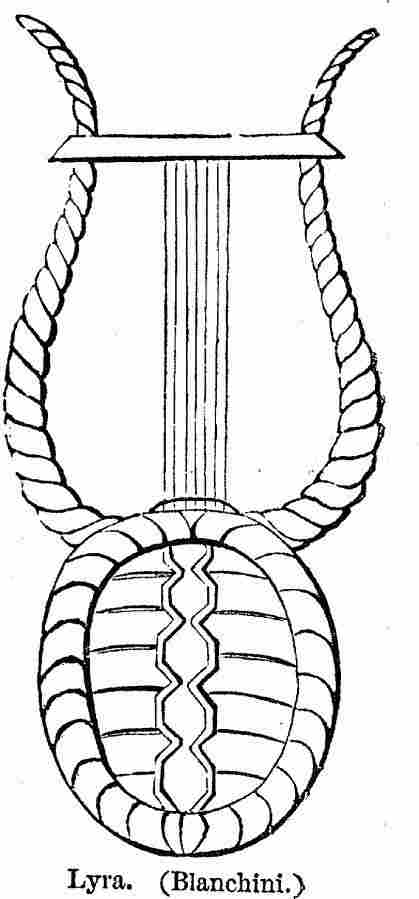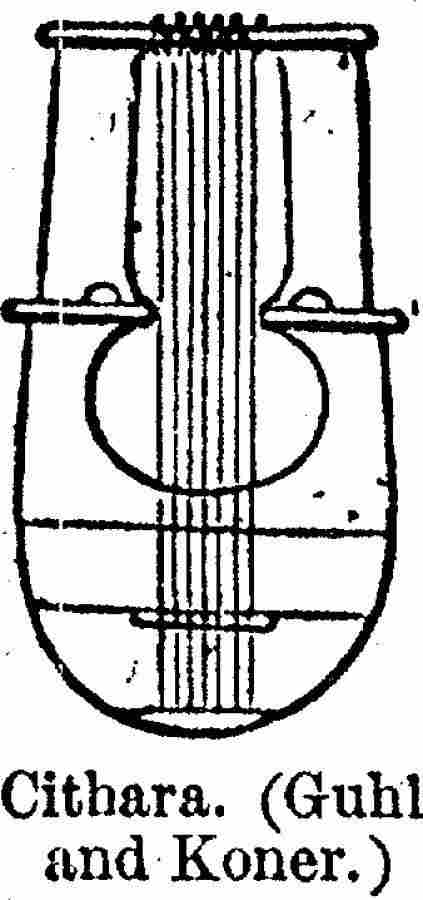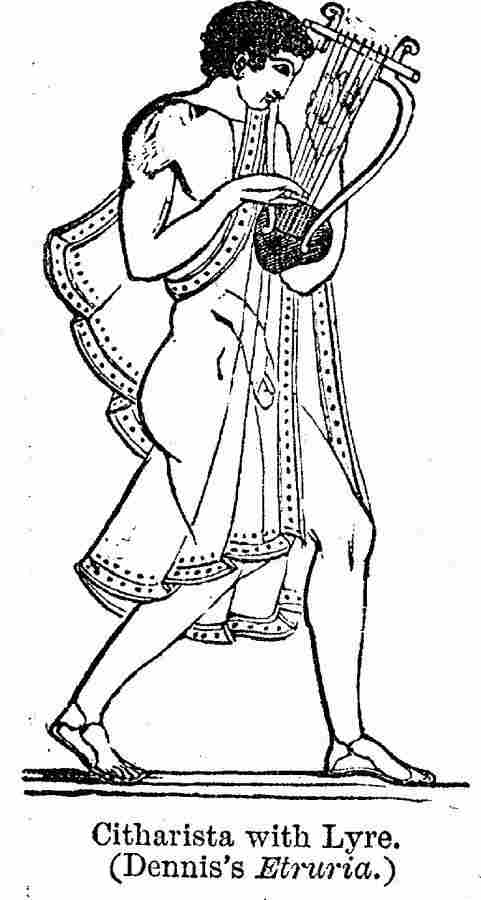.
LYRA (Lat. fides), a lyre, the chief stringed instrument used in Greek music. Two main varieties are known to us from ancient art and literature, viz. the lyre (λύρα) properly so called, and the cithara (κιθάρα).<
The distinctness of the lyre and the cithara may be shown from

Lyra. (Blanchini.)
Plato (Rep. iii. p. 399 D, λύρα δή σοι, ἧν δ᾽ἐγώ, καὶ κιθάρα λείπεται κατὰ πόλιν χρήσιμα), and from Aristotle, who excludes the cithara from education (Pol. 8.6 = p. 1341, 18, οὔτε γὰρ αὐλοὺς εἰς παιδείαν ἀκτέον οὔτ᾽ ἄαλλο τεχνικὸν ὄργανον, οἷον κιθάραν κἂν εἴ τι τοιοῦτον ἕτερόν ἐστιν) Mythologists generally taught that the cithara was invented by Apollo, the lyre by Hermes (Paus. 5.14, 8). The difference between the two instruments seems to be sufficiently ascertained from the representations of them [p. 2.105]found on ancient monuments, especially painted vases, on which two well-marked types can

Cithara (Guhl and Koner.)
be traced. One of these answers closely to the description which the author of the Homeric hymn to Hermes gives of the lyre invented by the youthful god (H. Merc. 41 ff.). The lower part or body of the instrument consists of a tortoise-shell, or of a wooden case in which the original tortoiseshell is more or less faithfully reflected. In this shell are fixed two curved arms (πήχεις) or horns, joined at the upper end by a crossbar (ζυγόν). The strings pass from the shell, over a bridge or fret of reeds (δόνακες), to the ζυγόν. The instruments of the other type are larger, and show a decided advance in point of construction. The shell is replaced by a wooden case, usually square or angular, and instead of “horns” we find the sides of the case prolonged upwards, so that the whole framework acts as a resonance box of considerable power. Now, it is clear from the evidence of the monuments that the first of these was the instrument of education and of every-day life; while the second was the “technical instrument,” seen in the hands of professional players (κιθαρῳδοί), who wear the long robe proper to musical contests and other festivals. The first, therefore, must be the lyre, and the second the cithara.
The early history of the lyre and cithara is obscure. In Homer we find a stringed instrument called the φόρμιγξ, used especially to accompany singing or epic recitation (ἀοιδή). We also hear, somewhat less frequently, of the κίθαρις: but there is no trace of a difference between them. The verb (φορμίζω is used of the κίθαρις (Od. 1.153-155); and conversely we find the phrase φόρμιγγι κιθαρίζειν (Il. 18.569). The word λύρα is post-Homeric: it occurs once in the Hymn to Hermes (50.423), but does not seem to have been in common use before the time of Pindar. It is worth noticing, as a consequence of the comparatively late date of the word, that the derivatives λυρίζω, λυριστής, are unknown in good Greek, κιθαρίζω and κιθαριστὴς being always used of the lyre and cithara alike; just as χαλκεύς, “bronze-smith,” was applied to workers in iron as well as in the older metal. It would be rash, however, to infer that the Homeric instrument resembled the cithara rather than the lyre. We may suppose that the later form of the cithara was developed gradually, retaining the original name, which therefore included all varieties, until the new word λύρα came into vogue for the commoner and more primitive kind. The author of the Hymn to Hermes recognises only one form, that of the lyre, to which he applies the terms κίθαρις and φόρμιγξ as well. The identity of the κίθαρις and the lyre is also maintained by Aristoxenus, the pupil of Aristotle (Ammon. de diff. Voc. p. 82, κίθαρις καὶ κιθάρα διαφέρει, φησὶν Ἀριστόξενος ἐν τῷ περὶ ὀργάνου: κίθαρις γάρ ἐστιν ἡ λύρα κ. τ. λ.).
Regarding the original number and tuning of the strings, contradictory accounts were current. According to one statement in Diodorus (1.16), Hermes was the author of harmony of sound, and in that character invented a lyre with three strings, answering to the three seasons. The same author elsewhere (5.75) says that Hermes invented his lyre in place of the cithara, which Apollo had laid aside in remorse for his cruelty to Marsyas. According to the Hymn to Hermes (50.51) the primitive lyre was one of seven strings: ἑπτὰ δὲ συμφώνους ὀἱ̈ων ἐτανύσσατο χορδάς.
On the other hand, the increase of the number of strings from four to seven appears to be claimed by Terpander, in two lines attributed to him: “ σοὶ δ᾽ἡμεῖς τετράγηρυν ἀποστέρξαντες ἀοιδὰν
ἑπτατόνῳ φόρμιγγι νέους κελαδήσομεν ὕμνους.
”
A different account, however, is given by Aristotle (Probl. 19.32), where he touches on the question why the interval of an Octave is not called δι᾽ὀκτώ (as a Fourth is διὰ τεσσάρων, a Fifth διὰ πέντε). He suggests by way of answer that the scale was formerly one of seven notes only, saying that Terpander left out the note called τριτη, and added the νήτη at the upper end of the scale (the octave of the ὑπάτη, or lowest note). If this account is the true one, what Terpander did was to raise the scale to the compass of an Octave, but without increasing the traditional number of strings. However this may be, the comparative antiquity of a scale of at least seven notes is proved by their names. The following are the notes of the central octave in the later system, with the modern notes which show the intervals on the diatonic scale:--
e ὑπάτη,, lit. “uppermost,” our “lowest” note.
f παρυπάτη, “” next to ὑπάτη.
g λιχανός, “forefinger” note.
a μέση, “middle” note.
b παραμέση.
c τρίτη, third, viz. from the νήτη.
d παρανήτη.
e νήτη, for νεάτη, “lowest,” our “highest.”
Of these names there is only one that is admittedly later than the rest, viz. παραμέση, which probably dates from the time when the heptachord of Terpander acquired an eighth string, and consequently a complete diatonic scale of the compass of an Octave. If we may trust a passage quoted from Philolaus (Nicom. p. 17), the gap then filled up was not that between μέση and τρίτη. Philolaus gives the name τρίτα (he writes in Doric) to the later παραμέση, the note which was a tone above the μέση. The change, therefore, consisted in inserting a note half a tone above the τρίτη of Philolaus, which new note then became the “third,” and made it necessary to find a new name--παραμέση--for the old τρίτη. But the language of Aristotle himself (Probl. 19.7, 32, 47) shows that the exact steps of this progress were no longer known. According to Nicomachus, the eighth string of the scale was added by Pythagoras. Probably, however, this is a mere inference from the Pythagorean discovery of the numerical ratios on which the musical intervals--the Octave, Fifth, Fourth, and Tone--are based. Another notice (Boeth. de Mus. 1.20) attributes the improvement to a certain Lycaon of Samos.
The lyre was originally played without the [p. 2.106]aid of a plectrum; and each string seems to have been sounded by a particular finger. Thus the lixano\s or “forefinger” was so called, according to Nicomachus (p. 22), because it was sounded by the forefinger of the left hand. It follows, as has been pointed out by Gevaert (ii. p. 254), that the left hand was used for the lower tetrachord, and that the little finger was not used to touch the strings. When the plectrum came into use, it was held in the right hand, and perhaps was specially employed for the air, while the softer tones produced by the fingers. of the left hand served for the accompaniment. This is suggested (though by no means proved) by the epigram of Agathias (Anth. Pat. 11.352) quoted by Gevaert: “ τὸν σοφὸν ἐν κιθάρῃ, τὸν μουσικὸν Ἀνδροτίωνα,
εἴρετό τις τοίην κρουματκὴν σοφίην:
δεξιτερὴν ὑπάτην ὁπότε πλήκτροισι δόνησας,
” ἡ λαιὴ νήτη πάλλεται αὐτομάτως.
The phenomenon here referred to is the “sympathy” by which a sounding body excites the vibration of another whose note is in unison with it, or with one of its harmonics.

Anacreon playing the Lyre. (Vase-painting in the British Museum.)
The seven-stringed lyre was still in use in the time of Pindar, unless we suppose that the epithets ἑπτάκτυπος (Pyth. 2, 70) and ἐπτάγλωσσος (Nem. 5, 24) are due to mere poetical tradition. On the other hand, we are told that Lasus of Hermione, who was an older contemporary of Pindar, introduced new notes, by which he broke up (διέρριψεν) the existing scale (Plut. Mus. cc. 29, 30) A passage quoted by Plutarch (l.c.) from the comic poet Pherecrates denounces a series of similar innovators--Melanippides, Phrynis, Cinesias, and

Citharista with Lyre. (Dennis's Etruria.)
finally Timotheus of Miletus, who “outraged music with his twelve strings.” The object of the additional strings seems to have been not so much to obtain greater compass as to make it possible to combine different modes or keys, perhaps also different genera (see the art. MUSICA), on the same instrument, and to pass easily from one to another. It is the “multiplicity of keys or scales” (πολυαρμονία) which is always ways associated with “multiplicity of strings” (πολυχορδία) in the minds of those who, like Plato, regarded such changes as dangerous and corrupting.
It is characteristic of the lyre and the cithara that the strings are all of the same length, so that the difference of pitch is entirely due to different thickness. In this respect they differed from instruments such as the harp, which have strings of different length, and again from those in which the length of the string is varied by the player, as in the case of the violin. The woodcuts above show the method of holding the lyre, in playing with the right hand only or with both. It was also played sitting, and supported on the knees. The cithara was held in the same manner. The harp type was represented in Greek music by the τρίγωνον or triangular harp, a Phrygian instrument, with which we find associated the Lydian πηκτίς. Both are condemned by Plato (Rep. iii. p. 399) for the excessive number of their strings. They are also mentioned together in a fragment of Sophocles, fr. 361: “ πολὺς δὲ Φρὺξ τρίγωνος ἀντίσπαστά τε
Λυδῆς ἐφυμνεῖ πηκτίδος συγχορδία.
”
The μάγαδις, which was closely akin to the πηκτίς, was so called from the bridge or fret (μαγάς), by which a string could be divided by the player, so as to yield a higher note. It had twenty strings, and admitted of playing the same tones simultaneously in different octaves (hence called μαγαδίζειν). This is also attributed by Aristotle (Probl. 19.14) to an instrument called the φοινίκιον or Phoenician lyre. The most perfect of all these instruments seems to have been the ἐπιγονεῖον, called after its inventor, Epigonus of Ambracia, which had forty strings. Besides these, we hear of the βάρβιτος, which is thought to have been nearly related to the lyre, also the νάβλα and the σαμβύκη (Strab. x. p.471). Several of these names are confessedly barbarous, and all the instruments now in question lay under the imputation of being more or less alien to genuine Greek art. They evidently enjoyed much popularity, but were never regarded as of equal dignity with the lyre and cithara.
(Compare Carl von Jan, De fidibus Graecorum, Berolini, 1859; Westphal, Geschichte der alten und mittelalterlichen Musik, Breslau, 1864; Gevaert, Histoire et Théorie de la Musique de l'Antiquité, Gand, 1875-81.)
Dictionary of Greek and Roman Antiquities
| Ancient Greece
Science, Technology , Medicine , Warfare, , Biographies , Life , Cities/Places/Maps , Arts , Literature , Philosophy ,Olympics, Mythology , History , Images Medieval Greece / Byzantine Empire Science, Technology, Arts, , Warfare , Literature, Biographies, Icons, History Modern Greece Cities, Islands, Regions, Fauna/Flora ,Biographies , History , Warfare, Science/Technology, Literature, Music , Arts , Film/Actors , Sport , Fashion --- |


